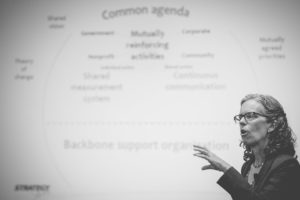
Image Courtesy of City of Philadelphia, JPG Photography
Strategy Arts was recently invited by the Mayor’s Office of Community, Empowerment and Opportunity to lead a workshop as part of their Shared Prosperity Roundtable. Shared Prosperity is CEO’s initiative to coordinate the efforts to address poverty in Philadelphia. It functions as a set of seven coordinated collective impact initiatives with many smaller working groups and a large number of participants. CEO wanted to offer the Shared Prosperity participants, as well as those involved in other collective impact initiatives in the City, a chance to focus on the work group experience. The workshop was titled “Stakeholder Training in Collective Impact.” During and after the workshop we welcome ongoing questions and dialogue from the participants. We found that a theme was emerging, work group participants were unsure of the level of impact they could have in their work groups: “But I’m ‘just’ a work group participant—is it really my job to drive change? And if so, how?”
Yes, it is really your role to drive change. The “how” is at the heart of collective impact.
It is through individual action based on a collective goal that we can drive change. The heart is central to the functions of the body to operate, without the individuals in each work group taking action, the collective impact is just an empty vessel with no heart, no soul. Work group participants often expect the backbone to take a “lead agency” role. This is because it leads to behaviors such as: waiting for direction, waiting for permission, waiting for funding. If collective impact is really going to work, the work groups and backbone need to step out of the “traditional” roles. Work group participants should act rather than wait, and allow the backbone to administrate rather than influence. The work is too important not to take on this new role.
Here are three tips for being the heart of the collective impact:
- #1 Show up: Determine the best work group for you. Then put the meetings on your calendar and make them a priority. Prepare for the meetings, read the agenda and other materials, and follow through on your actions. Participate and engage. Be a part of making the meetings rich, meaningful and worthwhile. Show up.
- #2 Make it work for you: Work group meetings should be beneficial to the collective and beneficial to the individual organization. Let the backbone and others in your work group know why you show up and what your organization can contribute. Also let them know what you need to make participation work for your organization. Talk about the work group meetings with others in your organization so they get the benefit of what you are learning in the work groups. If it’s not working, determine why it isn’t and address the issue. Try and try again. The issues are important enough to be sure you are putting your all into the collective.
- #3 Step into leadership: Work group leaders are critical for encouraging engagement, keeping focused on the collective’s priorities, fostering authentic dialogue and driving action. Take a leadership role. Lead a collective action that your work group chooses. Be a voice for change—find platforms for sharing about the issue that the collective is addressing, use the collective as a leveraging point to challenge others. Lead a work group.
Implementation of the collective impact method varies. Each initiative discovers how it works for their goal and their context. Yet the transformative work happens at the work group level. When work group participants embrace their role and join the collective in figuring out how to drive change – for their issue in their time and place.
If the backbone is the spine, then work group participants are truly the beating hearts of collective impact.

